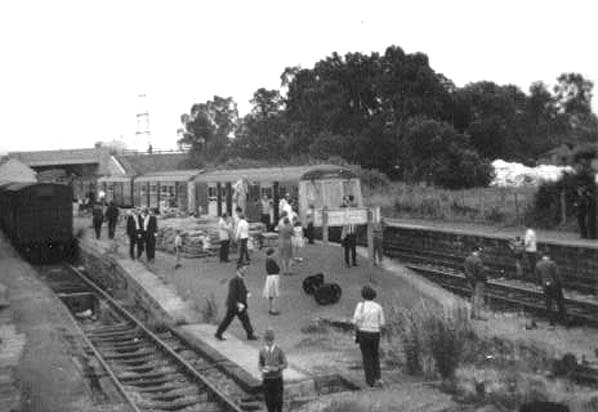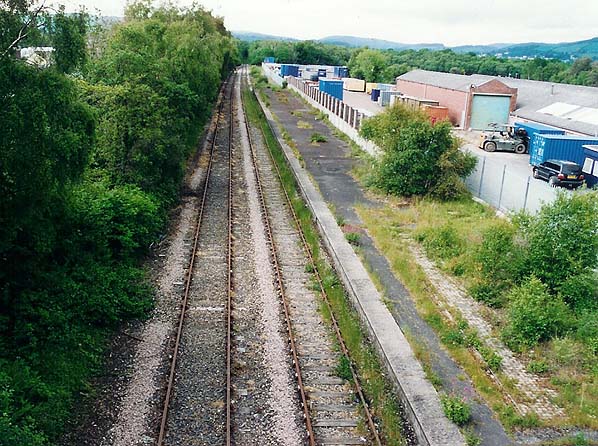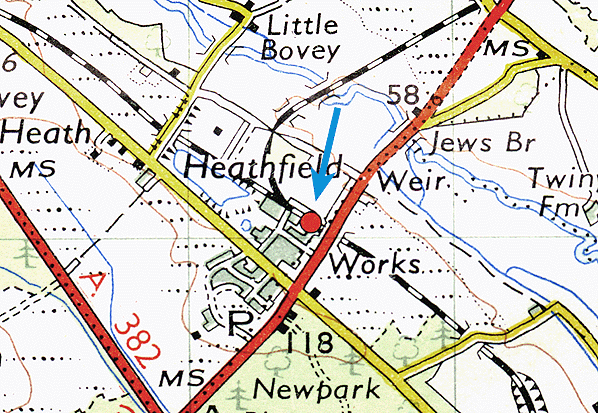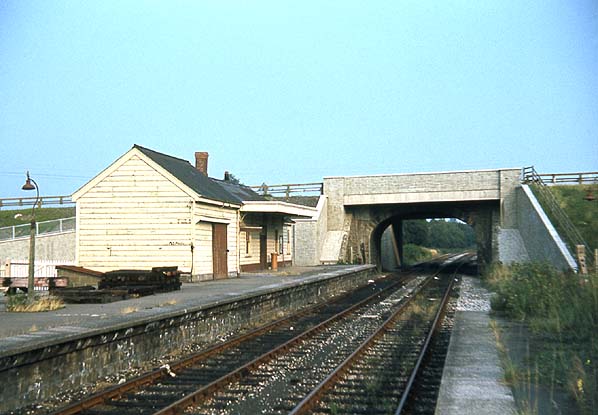|
Notes: The station was opened as Chudleigh Road and was renamed
Heathfield on 1st October 1882 shortly before it became a junction. Initially the station only had one platform serving the Moretonhampstead branch. In 1927 this platform was extended and a new passing loop and platform was provided for down trains came into use on 24th May 1927. Both platforms were signalled for reversible running until 1943 when the crossover was removed.
A loop siding was provided south of Heathfield in about 1913, by 1957 the siding was used for loading ball clay.
General goods traffic ceased on 14th June 1965 but coal traffic continued until 4th December 1967.
BRIEF HISTORY OF THE MORETONHAMSTEAD BRANCH
The line ran from the main line at Newton Abbot and following the valleys of the rivers Teign and Bovey some 12 miles to the terminus at Moretonhampstead; rising to a height of over 500ft to the edge of Dartmoor. From just south of Bovey to Teigngrace the line also followed the route of Devon’s first permanent railway, the Haytor Tramway which was used to transport granite from Haytor on Dartmoor towards the docks at Teignmouth. The railways tracks were constructed totally of stone.
The Moreton & South Devon Railway Company Act was passed in 1862 for a broad gauge line from Newton Abbot to Moretonhampstead. Local people were slow to subscribe and bad weather delayed construction with the line finally opening on 4th July 1866. From the outset, the service was provided by the South Devon Railway who absorbed the local company in 1872. The bridges on the line were constructed for double track but never used as such. Goods traffic began on the line on 8th October, three months after the line opened to passengers. Initially the service was poor and traffic was sparse until the end of the century by which time the line was well used. The South Devon Railway was absorbed by the GWR in 1878 and the line was converted from broad gauge to standard gauge between 20th and 23rd May 1892.
In 1906 the GWR began running busses from Moretonhampstead to Chagford in connection with the trains and as the Torbay resorts grew in popularity visitors flocked to the railway. Despite road competition the branch was busy until WW2 but no effort was made to attract business back to the line after the war.
British Railways claimed that the line was losing over £17,000 a year so it was announced that passenger service would be withdrawn on 2nd March 1959. This caused much local discussion.
The closure of the Teign Valley line from Exeter in 1958 has hastened the demise of the line with a huge reduction in passenger traffic at the junction station of Heathfield. The last public passenger train left Moretonhampstead on 28th February 1959 ending 92 years continuous service.
Initially freight traffic to Moretonhampstead was retained but this was cut back to Bovey on 6th April 1964. Track lifting north of Bovey commenced in 1965 and was completed on 21st June 1966. The freight service between Heathfield & Bovey was withdrawn on 4th December 1967. The last passenger excursion ran to Bovey on 5th April 1970 with four trains running during the day. Track lifting north of Heathfield was completed by early 1971.
The carriage of fuel oil, ball clay and bananas from Heathfield continued, although Heathfield station was unstaffed after 5th June 1972 and the banana traffic ceased in 1975.
The line had its share of royal visitors over the years, in 1983 The Prince and Princess of Wales spent the night in the royal train just south of Teigngrace. The Prince departed from Teigngrace Halt the following morning whereas the Princess departed from Heathfield, both attending separate engagements.
In 1986 construction of the Bovey bypass started following the route of the track from just North of Bovey station down through Brimley and on towards pottery bridge.
After 1996 the remaining section of line was virtually abandoned with only two passenger excursions visiting the line in 1997, but in 1998 a once weekly service was introduced between Newton Abbot and Timber Siding at Heathfield taking ball clay away from a local pit where it is still mined. Occasional passenger excursions still visit Heathfield, most recently on 25.5.2002.
BRIEF HISTORY OF THE TEIGN VALLEY RAILWAY
The Teign Valley Line was originally authorised in 1863 as a broad gauge line, although it did not open until 1882. The line ran as standard gauge from Heathfield to Ashton, although it was isolated from the GWR system as the Moretonhampstead line at Heathfield was still broad gauge.
Some forty years later, the Exeter, Teign Valley and Chagford railway was formed to build a line from Exeter to join up with the existing line connecting at Christow station. This opened on 1st July 1903 some 9 years after the first sod had been cut by Lady Northcote, wife of the Member of Parliament for Exeter on 7th November 1894.
The 1st official train left St Thomas station (Exeter) at 3.40pm and arrived at Ide at 4pm calling at all the stations on the line where each parish council laid on festivities and the usual address by councilors.
The line which extends from Heathfield on the Newton Abbot to Moretonhampstead line in the south to Exeter on the main London to Cornwall line covers a total of 17 miles. It consists of approximately 25 bridges, 30 culverts and 2 tunnels, one each side of Longdown station. These tunnels were built to hide the offensive sight of the trains from Edward Byrom of Culver House which stands in parkland above the railway.
The largest customer for goods traffic on the line was the Teign Valley Granite Company which had quarries at Trusham and Crockham. Not only was the line used for local connections but it also provided an alternative route to Cornwall, bypassing the troublesome route from Exeter to Newton Abbot which regularly (and still does) suffered from the elements from the sea around Dawlish
Prior to the opening of the through line in 1903, passenger services on the original line consisted of 5 trains daily in each direction on weekdays only, with no trains at all on Sundays. When the line opened from Exeter the passenger service was integrated with that of the Teign Valley Railway. The Exeter Railway and the Teign Valley Railway were both absorbed into the Great Western Railway in 1923.
Passenger numbers reached their peak in the 1930’s with seven daily services provided each way between Exeter and Heathfield. During World War 2 this was reduced to four trains in each direction, still with no trains on a Sunday. This was increased to five daily trains after the war.
By then it was becoming obvious that the branch was going into decline as more people took to the motor car as their main form of transport, a trend that was happening nationally. As a result BR decided to withdraw passenger services a full 5 years before the start of the ‘Beeching Axe’, even though Ashton station had only been repainted the year before closure.
In 1957 The British Transport Commission proposed to withdraw the passenger train service between Exeter (St David’s) and Heathfield and to close down Longdown station. It was followed in early 1958 by a further notice saying that as from 3rd March 1958 that the passenger train service between Exeter (St David’s) and Heathfield stations would be permanently withdrawn and Longdown, Alphington, Ide, Dunsford and Chudleigh Knighton would be closed for passengers and goods. The parcel service would still continue for the delivery and collection of parcels at Chudleigh, Trusham, Ashton and Christow stations. The line was granted a short reprieve by a protest by St Thomas Rural District Council (Exeter) because of the inadequate bus service, this reprieve was short lived as on 9th June 1958 the passenger service was finally withdrawn and the section of line from Exeter to Christow closed completely.
The track on this section was lifted in February 1962 except for the short length from Exeter to Alphington Road sidings (Marsh Barton Industrial estate). This part of the line still survives today, serving a scrap metal company and this is still used regularly (2010), beyond here towards Heathfield the line has been severed by a supermarket.
BR's reasoning behind the closure was the line was only used for an average of 193 daily journeys and closure would give them a saving of £15,000 per annum with a further saving of £30,000 that would be required for general up-keep of the line.
March 1961 saw flooding which damaged the line between Christow and Ashton resulting in the closure of the line east of Trusham. BR officially closed the section of line between Heathfield and Crockham sidings (just south of Trusham) on 1st July 1968.
Further reading: The Heathfield to Exeter (Teign Valley) Railway by Lawrence Pomroy - Forest Publishing 1995 ISBN 1 873029 04 7
Teign Valley Line by Peter Kay - Wild Swan 1996 ISBN 1 874103283
Branch Line to Moretonhampstead (including Heathfield - Exeter) by Vic Mitchell & Keith Smith
Middleton Press 1998 ISBN 1 901706 273
Walking West Country Railways by Christopher Somerville - David & Charles 1979
ISBN 0 715381421
Devon's Railways by Helen Harris - Bossinney Books 2001 ISBN 899383 40 9
Branch Lines of Devon by Colin Maggs
- Sutton Publishing 1995 ISBN 1 84015 022x
To see other Stations on the Moretonhampstead branch click on the station name: Teigngrace Halt, Brimley Halt, Bovey, Pullabrook Halt & Moretonhampstead
To see other Stations on the Teign Valley Railway click on the station name: Heathfield, Chudleigh Knightion, Chudleigh, Trusham, Ashton, Christow, Dunsford Halt, Longdown, Ide Halt & Alphington Halt |

old6.jpg)

 Heathfield
Station in June 2005 - seen from A38 overbridge
Heathfield
Station in June 2005 - seen from A38 overbridge Home
Page
Home
Page















